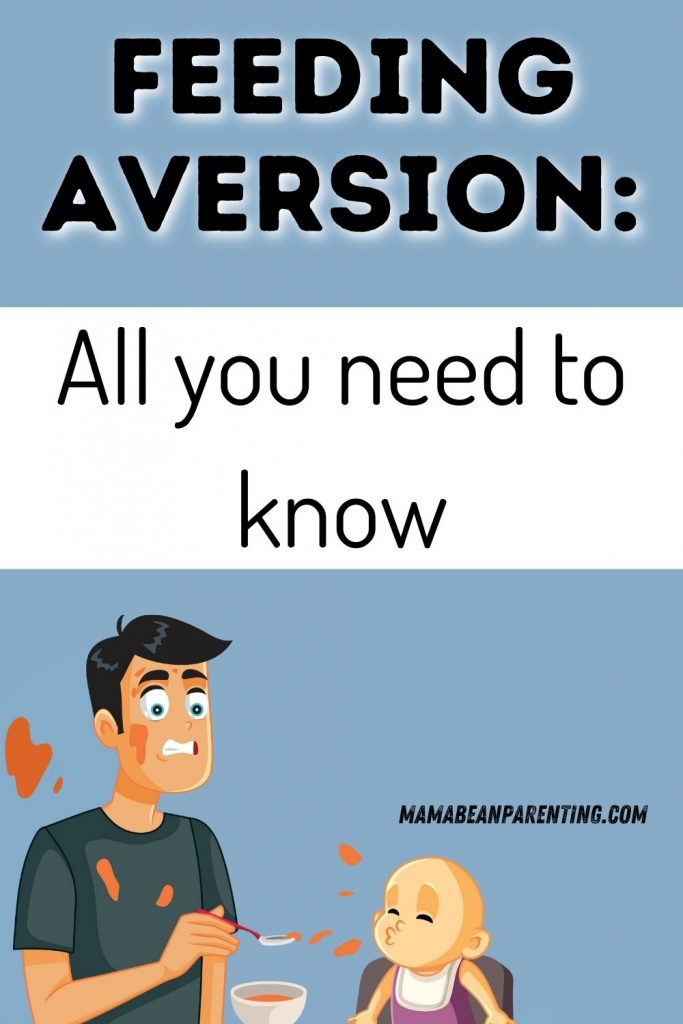Just when you’ve solved one problem, another one comes up. No one said it was going to be easy. And if they did, they likely don’t have kids. There’s always something, isn’t there?
Now you’ve got another problem on your plate: feeding aversion.
Ever heard of it? You likely have. It’s not that uncommon, actually. Many parents and babies struggle with it. Sure, it’s frustrating, but there’s a way to deal with it effectively.
As a matter of fact, there are many solutions that you can try, but we’ll get to them in due time. First, we have to go over what it means when your baby outright refuses to eat.
Your baby’s hungry. All the cues are there. But, they just don’t want to eat.
What can you do about it? Besides, you know, pulling out your hair?
Whether this has been going on for a long while or if it’s just another chapter in the book of challenges that parents have to navigate – we’re here to help you find a solution.
So, What Exactly Is a Feeding Aversion?

Your baby seems fine, right? They’re physically, emotionally and mentally healthy, but, for some unknown reason, they just don’t want to eat, even though they are hungry.
Now, that can be frustrating. It’s all right to feel a little bit frustrated, but you have to remain calm, because it’s calmness that will help you find and apply an efficient solution.
The so-called feeding aversion, known also as a bottle aversion, is a situation in which a baby refuses to eat, even though they have eaten healthily and normally in the past.
So, what exactly happened?
What changed? It’s very difficult to pinpoint the exact cause, but what you do have to know for now is that a feeding aversion can be linked to fear.
For some reason, your baby has concocted an equation that reads: eating equals bad.
Therefore, they eat very little or skip meals altogether.
That’s not always the case, though. A feeding aversion can be caused by many things.
Whenever you try to feed your baby, they react in a negative way. Either they start crying, fussing or turning their head away. No matter the reaction, it’s always the same struggle.
What makes this problem very tricky to navigate, especially if you’re a new, inexperienced parent with no history of such experiences, is the fact that your baby still sometimes eats.
Yes, they will eat when they’re on the brink of starvation, but what good does that accomplish? Your baby’s not eating enough to stay healthy and to develop properly.
Maybe they take a few sucks and call it a day.
Feeding aversion manifests in different ways. So, how do you get to the bottom of it? You need to react quickly, because you want your baby to thrive. They need their nutrients.
However, before we proceed, it helps to identify the potential causes. If you manage to figure out what causes your baby to refuse to eat, it gets much easier to find a solution.
What Causes a Feeding Aversion?

Where to even start? There’s just so many potential causes. Even though all of this may seem overwhelming for you, as it surely is, knowing the causes will certainly help you.
You’re no doctor (or maybe you are), but it’s your firsthand experience during feeding times that’s key in pinpointing the exact cause. Still, seeking professional help is crucial.
When in doubt, see a pediatrician. No two ways about it.
• Your baby is stressed or anxious.
Think about it. When you’re being insistent to the point where it’s annoying, it’s only natural for your precious little sweetheart to react by developing a feeding aversion.
Imagine someone forcing you to eat all the time. Even when you’re actually hungry, when someone’s practically forcing food into your mouth – of course you’re going to protest.
If you’re pressuring your baby to eat, they can – and probably will – eventually object.
That’s because your very act of pressuring them creates a stressful situation. In doing so, you’re forcing your baby to eat against their will. That inevitably leads to issues later on.
Whether you’re breastfeeding your baby and trying to make milk fattier, giving them milk from a bottle or introducing solid foods – observe their cues. Study their reactions. Turn it into a fun experience.
• Your baby could be experiencing pain and discomfort.
Now, this is a broad one. If there’s any reason for your little one to associate pain with feeding, you’re going to have a feeding aversion on your hands as soon as it happens.
Check to see if your baby has mouth ulcers.
If you do notice these round, white sores, it could explain their feeding aversion. The good part is that these sores go away on their own. The bad part? Takes about a week or two.
However, if the issue persists, it’s important to seek medical attention.
If your baby’s bringing up milk or feeling sick after feeding times, that would indicate acid reflux, which, while uncomfortable, is actually a common disease in young babies.
It goes away eventually, but requires extra care on your part.
Another potential cause that could be behind your baby’s feeding aversion is CMPI, which stands for Cow’s Milk Protein Intolerance, commonly referred to as milk protein allergy.
While milk protein allergy fades with time, seeing a pediatrician is a must as soon as you notice even the subtlest of symptoms. You want to react early to prevent issues later on.
These three conditions are the most common. They make it very difficult for babies to suck. Swallowing becomes a painful sensation that causes pain and feeding aversion.
Other medical conditions include chronic constipation and gastroparesis.
Even ear infections can lead to a feeding aversion.
While unpleasant, there are treatments and strategies to navigate these dilemmas. But, if you do suspect that your baby is experiencing pain and discomfort – don’t pressure them.
Unsurprisingly, that only worsens things and entrenches their feeding aversion deeper.
• Feeding aversion due to fears.
It’s not uncommon for babies to develop a fear of feeding if they’ve experienced some sort of traumatic experience in the past. You will have to unearth the root of the fear.
Does anything spring to mind? It doesn’t matter if you’re breastfeeding your baby or if they have a bottle aversion, a single traumatic event can totally rewire their little brains.
For example, if they’ve experienced pain and discomfort while breastfeeding, they may anticipate that pain to be inevitable, regardless if their symptoms had actually passed.
Now, that’s a tricky dilemma to navigate. It takes baby steps to overcome fear.
You have to be extra careful, especially if you were force-feeding your baby in the past.
A feeding or bottle aversion could come up if you’ve been forcing your baby to eat too much. If you were being persistent despite their crying – that very well materializes fear.
• There’s a lot of other potential causes to consider.
Feeding aversions are to be expected if your baby has a developmental disorder or disability. Yes, it’s hard, but this is yet another problem that you will have to overcome.
If you’ve given birth prematurely, there’s a good chance that your baby may develop a feeding or bottle aversion. Best to be prepared for eating difficulties if that’s the case.
It’s not always so serious, though. Sometimes, it’s just plain old disgust. Whether you’re mixing medication into the milk or introducing new foods, babies can find it disgusting.
That’s their right, but you still have to keep them well-fed by finding alternatives.
Luckily, feeding aversions are not an unsolvable dilemma.
You can help your baby overcome it, but sometimes it takes not only your effort and patience, but professional help. Seeing your pediatrician is the best call you can make.
Does Your Baby Have a Feeding Aversion?

No matter the cause, a feeding aversion temporarily hinders your baby’s development. Temporarily, yes, but if left untreated, it can cause serious damage to your baby’s health.
In some cases, it can even leave long-term consequences.
If your little one starts showing signs of feeding or bottle aversion – react immediately.
But, you still have to know how to recognize the signs. So, here’s a breakdown.
Obviously, the first sign is when your baby refuses to eat. They skip a meal. They skip a meal, but they don’t seem to be phased by it. They’re hungry – but not communicating it.
This may confuse you at first, but the pattern will continue if it’s a feeding aversion.
The cues that your baby is hungry are still there, but they still don’t want to eat. This is where parents make the mistake of trying to force-feed their baby. That’s a bad idea.
Force-feeding your baby can only further embed the issue. So, don’t do that.
Do you use a bib during feeding times? If so, study your baby’s reaction. Babies are capable of making meaningful connections, such as that of a bib that predates feeding.
If your baby starts fussing when you put the bib on them – that’s a telltale sign.
Any kind of fussing or crying when you’re about to feed them is a sign that they may have developed a feeding aversion. They tend to react in advance to the actual feeding.
Keep that in mind, because you can use that information to test your baby. For example, you can present the bottle to them and study their reaction. This sheds light on the issue.
If your baby gets agitated by the mere sight of a bottle, it’s basically confirmation that they have bottle aversion. The same rule of thumb actually applies to any manner of feeding.
Parents that aren’t aware of this condition tend to force their baby to eat, but the signs are already recognizable: the baby clamps their mouth shut, turns their head, and cries out.
It doesn’t matter how you feed them. Whether it’s a spoon, a bottle, or your breast, a feeding aversion can manifest in many forms, and the signs are practically the same.
Don’t assume that a feeding or bottle aversion means that your baby never eats. That’s not the case. Your baby will continue to eat occasionally, in very small portions like a bird.
For example, they may take a sip out of the bottle, only to retreat immediately.
Whenever your baby’s back arches, that’s a sign that they want to pull away.
There are so many other variations of this problem, such as a baby eating only when they’re sleepy, or a baby refusing to drink milk but eating solid foods without an issue.
What’s certain is that the signs will probably be unique. Maybe it’s one thing, maybe a combination of symptoms, but you will have to put on your detective hat to solve it.
As soon as you notice any of these signs, it’s crucial to respond right away.
So, let’s take a moment to review the most common symptoms again:
- Baby refusing to eat.
- Skipping meals.
- Hungry, but reluctant to eat.
- Fussing or crying before feeding.
- Baby turns their head during feeding.
- Eats only when they’re ravenously hungry.
- Baby arches their back to get away.
- Eating only when sleepy.
- Drinking milk, refusing solids – or vice-versa.
How Do You Help Your Baby Overcome It?

The recurring theme thus far, as you may have noticed, is force-feeding. So, let’s make it very clear: never pressure your baby to eat. It can only worsen their feeding aversion.
The moment you start to force your baby to eat against their wishes, you open up a pathway for the condition to enroot itself deeper, which further complicates things.
In doing so, you’re actually upsetting your baby and creating a stressful situation.
Do you remember when we said that fear causes feeding aversion? When you’re forcing your child to eat and being all tense about it, you’re creating room for that fear to thrive.
This can spiral out of control very fast.
We understand how difficult it might be to resist the temptation to get your precious little angel to eat, especially when their bodies weaken due to not receiving enough nutrients.
You care about your baby, of course. But, you’re only making it worse by pressuring your child. Doing this can even lead to feeding aversion, even if there were no signs previously.
Force-feeding is a big no-no in any kind of form.
From pushing the nipple into their mouth, restraining them from keeping them in place, attempting to trick or outsmart them, and being persistent about it – avoid such behavior.
Seek, instead, more efficient solutions. So, what can you do about it?
• Seek medical attention and professional guidance.
This is the best thing you can do.
As soon as you notice any of the symptoms, schedule a doctor’s appointment.
Take your fussy baby to the doctor’s office for a medical examination. They will assess the situation thoroughly and explore potential causes behind your baby’s feeding aversion.
Share what you know. Your firsthand experience matters.
The doctors will run tests, if necessary, to see if there’s an underlying medical condition.
Depending on what they find (or don’t find), they may follow up with treatments such as medications or changes to your baby’s diet or feeding habits. Maybe your approach, too.
If a condition is identified, treatments begin until the behavior stops.
• Speech therapy may be needed.
Speech therapy is about making sure that your baby can suck and swallow effortlessly. If your baby is finding it hard to suck or swallow, there’s likely an underlying medical issue.
In that case, a speech therapist will provide further context and treatment options.
Therapies vary, but the most common one is as simple as a swallowing exercise.
However, if the doctor assesses that your baby can suck and swallow without any pain or discomfort, then the problem may very well verge on the psychological side of things.
• Treatments in case of oral aversion.
As opposed to feeding or bottle aversion, an oral aversion is when a baby dislikes or fears anything touching their mouth. So, it’s not necessarily just about food or milk.
In case of oral aversion, it’s a bit more complex.
They may even object to you washing their teeth with a toothbrush, depending on the severity of the issue. Other symptoms include coughing, choking and delayed growth.
Oral aversion is most common in premature babies, but it can also be caused by sensory issues. For example, a sensory processing disorder can lead to oral aversion in babies.
If your child is struggling with oral aversion, there’s a variety of things that you can try at home, such as not forcing them to eat, but rather encouraging them in a positive way.
If they have a selective food choices, for example, structure their diet around it.
However, the most important thing you can do is seek medical attention. In case of an oral aversion, a baby needs to undergo evaluation in order to find the most efficient treatment.
Treatments vary, of course, depending on the cause, but the doctors know what to do.
• Try changing up the bottle.
If your little one keeps refusing the bottle, you may find better luck with a different type of bottle. Consider switching to a slower flow rate so as to mimic the flow of the breast.
Experimenting with different flow rates may help you find a suitable solution.
Now, this applies only if your baby has a bottle aversion. Bottle feeding takes some time to get used to for your baby, especially if you’re just transitioning from breastfeeding.
It’s natural to expect some feeding problems until you work it out together.
Just make sure that the experience is not unpleasant or stressful when you feed your little one. This could easily spiral out of control fast if you’re not careful how you feed them.
A bottle aversion could quickly turn into a situation where you struggle to feed your baby by any means. So, ensure your little one’s health by always staying calm and composed.
Be your baby’s comfort zone.
• Try a different feeding position.
Making changes to how you keep your little pumpkin fed can make a huge difference. That implies not only changing the feeding environment, but feeding positions, too.
There are a few different ways to breastfeed your child, but the most important thing is to make sure that they’re completely comfortable so that the experience can be enjoyable.
Whether you’re breastfeeding or bottle feeding, support your baby’s head.
You may also want to look into establishing a better breastfeeding pumping schedule.
One thing that’s helped many parents is the incorporation of relaxing activities prior to the actual feeding. This is especially helpful for babies struggling with feeding aversion.
By taking a few moments to help relax your baby, you can significantly improve your chances of keeping them fed, the reason being that this helps relieve stress and anxiety.
• Experiment with a different formula.
Not all baby formulas taste the same. The differences in how they taste can either be noticeable or subtle. Either way, not all babies will love the same exact baby formulas.
If you’re experiencing feeding problems with your formula, try changing things up. Being persistent and ignoring your little one’s cues can develop an aversion to feeding.
Your doctor may recommend the same approach if it happens that your baby shows signs of a milk protein allergy. If so, you will have to exclude cow’s milk protein from their diet.
Another subtle strategy that may yield favorable results when dealing with a feeding aversion is trying different formula temperatures. But, this does take a bit of know-how.
If you’re going to experiment with different formulas, you should first consult with your pediatrician so that you may work together toward finding a formula that works best.
• Patience is key.
Whether you’re breastfeeding or bottle feeding, regardless if your baby is 2 months old or 9 months old, a feeding aversion can happen at any given point for a variety of causes.
It could also happen if you’re starting breastfeeding later than expected.
Dealing with it is never easy, but it’s outright impossible without patience.
Without it, you run the risk of making the situation much, much worse.
An aversion to feeding is a common problem that many parents face at some point, but the most common mistake that you can make is choosing to ignore the clear symptoms.
Not only do parents tend to ignore them, they press the issue and force-feed their baby.
You have to be patient and composed as you work alongside your pediatrician to unroot the cause and find viable and efficient treatments that can put a stop to this behavior.
Whether it’s a feeding aversion or a bottle aversion – treatments do exist.
So, remain calm, patient and focused on prioritizing your baby’s health.
In Conclusion

While it’s difficult to pinpoint the exact cause of a feeding aversion, there are a variety of treatment options available. However, uncovering the cause should be your top priority.
At the very least, you should keep an eye out for any symptoms.
As soon as you experience difficulty breastfeeding or bottle feeding, tread carefully. Test the waters to see if it’s just a one time thing, or a deeper more complicated condition.
The causes vary from acid reflux to psychological obstacles, but you don’t have to burden yourself with the task of evaluating your baby’s health. Leave that to the professionals.
Instead, be on the lookout for any signs that point to a feeding aversion, and react by scheduling a doctor’s appointment right away so that you may proceed with treatments.
Above all else, whether it’s a feeding aversion or a bottle aversion, remember not to force your baby to eat. Sure, it’s frustrating at first, and worrying, but you have to remain calm.
Do this, and you will get your baby’s health back on track in no time.

Mother of three and a primary school teacher. I’ve always loved being around children and helping them, so I chose my path as a teacher. It is sometimes hectic with three children, but I am 100 percent into it and wouldn’t change it for anything in the world.


